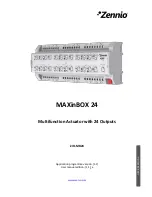
MC96FR116C
November, 2018 Rev.1.8
155
I2CSR (I
2
C Status Register)
9D
H
7
6
5
4
3
2
1
0
GCALL
TEND
STOP
SSEL
MLOST
BUSY
TMODE
RXACK
R
R
R
R
R
R
R
R
Initial value : 00
H
GCALL
This bit has different meaning depending on whether I
2
C is master or
slave. Note 1)
When I
2
C is a master, this bit represents whether it received AACK
(Address ACK) from slave.
When I
2
C is a slave, this bit is used to indicate general call.
0
No AACK is received (Master mode)
1
AACK is received (Master mode)
0
Received address is not general call address (Slave mode)
1
General call address is detected (Slave mode)
TEND
This bit is set when 1-Byte of data is transferred completely. Note 1)
0
1 byte of data is not completely transferred
1
1 byte of data is completely transferred
STOP
This bit is set when STOP condition is detected. Note 1)
0
No STOP condition is detected
1
STOP condition is detected
SSEL
This bit is set when I
2
C is addressed by other master. Note 1)
0
I
2
C is not selected as slave
1
I
2
C is addressed by other master and acts as a slave
MLOST
This bit represents the result of bus arbitration in master mode. Note 1)
0
I
2
C maintains bus mastership
1
I
2
C has lost bus mastership during arbitration process
BUSY
This bit reflects bus status.
0
I
2
C bus is idle, so any master can issue a START condition
1
I
2
C bus is busy
TMODE
This bit is used to indicate whether I
2
C is transmitter or receiver.
0
I
2
C is a receiver
1
I
2
C is a transmitter
RXACK
This bit shows the state of ACK signal.
0
No ACK is received
1
ACK is generated at ninth SCL period
Note 1) These bits can be source of interrupt.
When an I
2
C interrupt occurs except for STOP interrupt, the SCL line is hold LOW. To release SCL,
write arbitrary value to I2CSR. When I2CSR is written, they TEND, STOP, SSEL, LOST, RXACK bits
are cleared.
















































